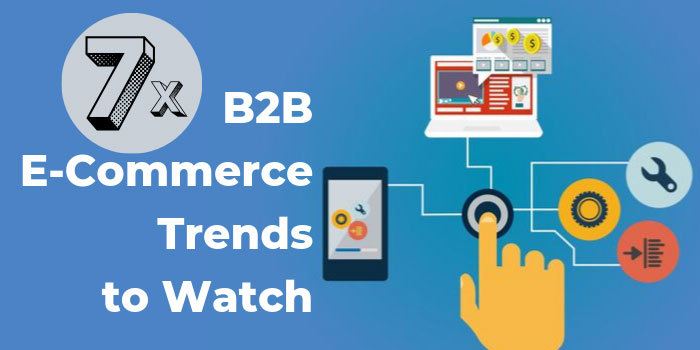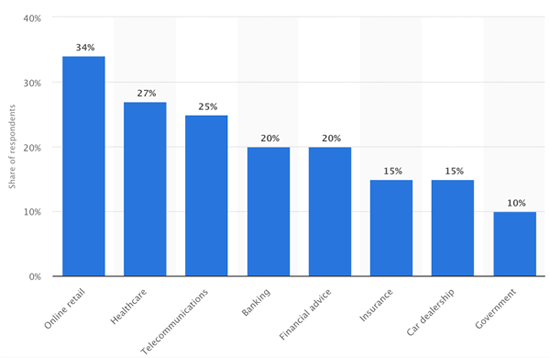If your business is not joining the e-commerce revolution, then you are missing out on the projected $4.8 trillion worldwide revenues for 2021. If you have already jumped into the bandwagon, watch out for these seven B2B e-commerce trends.
The number of worldwide digital buyers is expected to reach 2.14 billion people in 2021. That means if your business is embracing effective e-commerce marketing tactics, you will reap big.
These days, the eCommerce market is almost omnipresent and B2B business of one of the most successful forms of business. The industry is growing at a lightning speed. For that reason, it is important for B2B sellers to keep up with the latest eCommerce trends.
In this article, we offer seven B2B eCommerce trends to watch as shared by Johnson Smith, an eCommerce expert, and a college paper writer.

#1 Big Data
Big data has and continues to take a huge role for B2B sellers that want to monitor and examine challenges so that they can yield huge incomes.
There is a huge number of companies that have already adopted Real-Time Big Data Analysis. The good thing about big data is that it can be used to forecast demand, methods to personalize the customer experience, and price optimization for the purpose of improving the ratio of sales.
Big data and analytics enable B2B sellers to recognize and classify customers according to their buying patterns and demographic details. That way, businesses can make decisions targeting their prospective customers thus maximizing their revenues.
#2 Artificial Intelligence
Artificial Intelligence (AI) is rapidly becoming a needed technology by eCommerce and B2B sellers since it can aid in the delivery of data-driven and practical insights to companies and organizations.
When B2B eCommerce sellers utilize AI, the benefits they can gain are noteworthy. According to a recent survey conducted by Hanover Research, respondents argued that Artificial Intelligence could help them in several ways. 45% of the respondents indicated that AI can play a big role in enhancing customer services, 44 % said it can help in satisfying customer needs, 42% termed AI as a tool for maximizing profits, 41% think AI is beneficial when it comes to saving costs, and 39% indicated that AI can help in beating the competition. These are just a few responses obtained in the survey.
Additionally, according to the 2017 report by Statista, 34% of respondents indicated that they would be comfortable receiving customer services from AI in an online retail business.

Acceptance of artificial intelligence chatbots by customers worldwide, as of 2017, by service [Statisca]
#3 Mobile eCommerce
The need for user experience is becoming something unavoidable for B2B sellers. For that reason, eCommerce businesses are being more persuaded to use mobile devices for selling.
“The number of people using mobile phones around the world is expected to reach 2.87B in 2020”, says Kristine Hines, a technology consultant, and custom essay writing expert.
Most of these users rely on their smartphones to research and buy products online since it is one of the easiest and convenient ways. In fact, mobile applications drive a huge percent of the website traffic.
B2B eCommerce companies are therefore inclined to use responsive themes so that their websites can load fast on any device.
#4 Secure Payments
Digital payment methods are not only tricky but are risky for B2B sellers. However, with the plenty of payment methods including commercial cards, bitcoins, e-checks, physical checks, and purchase orders, B2B sellers have no option but to embrace all of it.
Different customers have their preferred method of paying for products or services. B2B businesses are already aware that if these payment methods are not put in place, the customer would likely move to another website there and then. This is a loss to the B2B businesses that are not actively using these payment methods.
#5 Personalization and Customer Engagement

Unlike in traditional shopping, eCommerce stores allow the customer to buy products or services without visiting a physical store. That means the customers do not interact with a real sales representative.
Moreover, the customers do not get a retail clerk who can recommend products or services of interests.
To make the customers feel that they are attended by a real person, ecommerce businesses are utilizing personalization opportunities on the entire shopping process.
Brands are using online data such as page visits, search queries, and purchase history to convert their online stores to best serve the customer rightly.
For instance, if you login to your Amazon account, you will see recommended products based on your purchase history, ads personalized to your search queries, and etc.
This trend is exploding and many e-commerce businesses are expected to follow suit.
A study has shown that customers spend 48% more when their experience is personalized. This also leads to trust-building for the business.
#6 Interactive Product Visualization
It’s not a secret: Most customers hesitate to click the “Buy” button when buying online. Well, this is understandable because a customer wants to be assured that the product will be exactly what they need and it is the quality they are looking for and not a knock-off before they enter their payment info.

Customers want to feel the product before buying it. While online reviews and influencer trends can help, they are not sufficient. Customers want to see the product, and if possible hold it on their hands to get rid of doubts.
The use of virtual reality, augmented reality, and 3D imaging helps customers to interact with a product through their computers or smartphones. Besides, each eCommerce company is expected to use an hr software to streamline their processes. ECommerce videos are also playing an important role as well.
#7 Constant Customer Engagement
Customer engagement is not only meant to be exercised before the point of purchase. It must be seen even after the point of purchase.
Customer engagement is important for e-commerce sellers given that it is more expensive to attract a new customer than to keep the present one.
Customer retention can be achieved by continuous advertising, email marketing, getting customer feedback, and content marketing.
All these strategies continue to play an important role in the online shopping industry.
Final Thoughts
The world of eCommerce continues to grow at fast speeds among B2B and B2C companies. For that reason, companies not only need to think about their customers but also focus on enhancing internal workflows.
Lastly, it’s important for eCommerce sellers to keep up with the latest trends in technology to keep them relevant and help them make more profits.

Justin Osborne is a freelance writer who loves to share his thoughts and opinions about education, writing and blogging with other people on different blogs and forums. Currently, he is working as a content marketer.
Author // Justin Osborne
